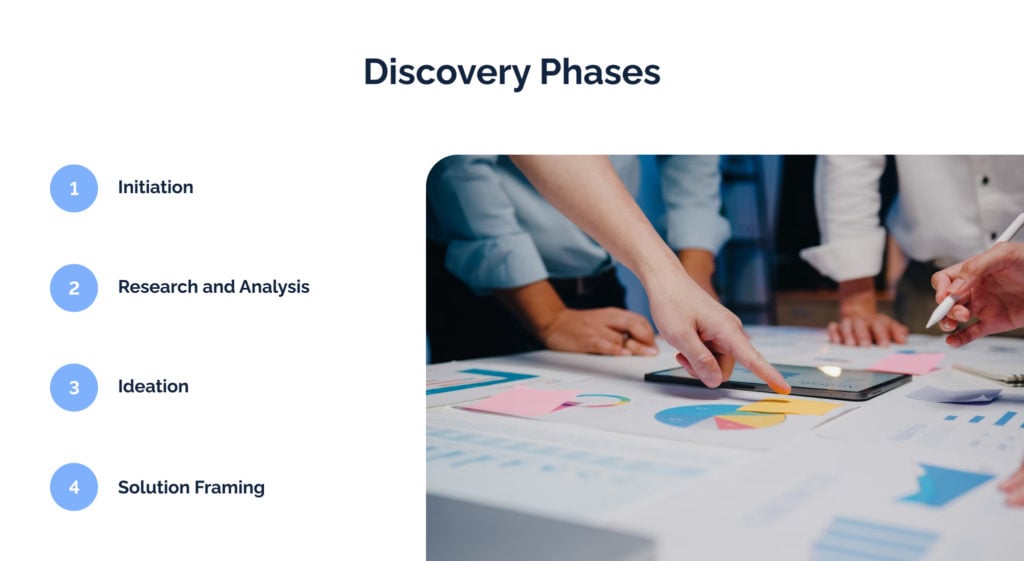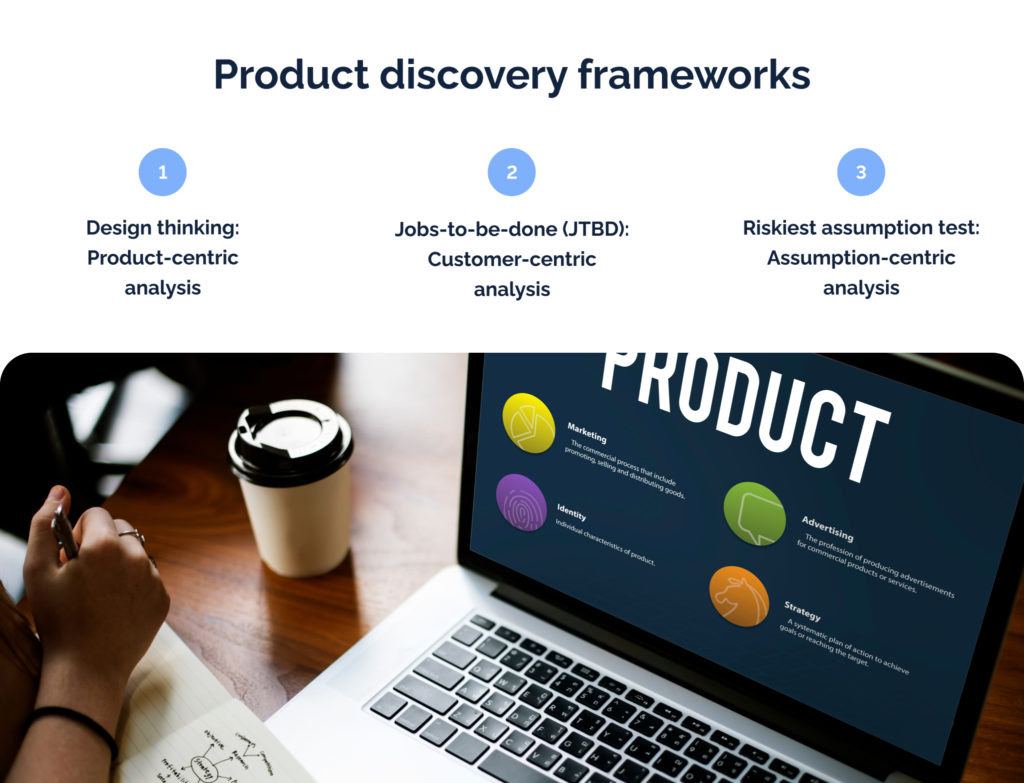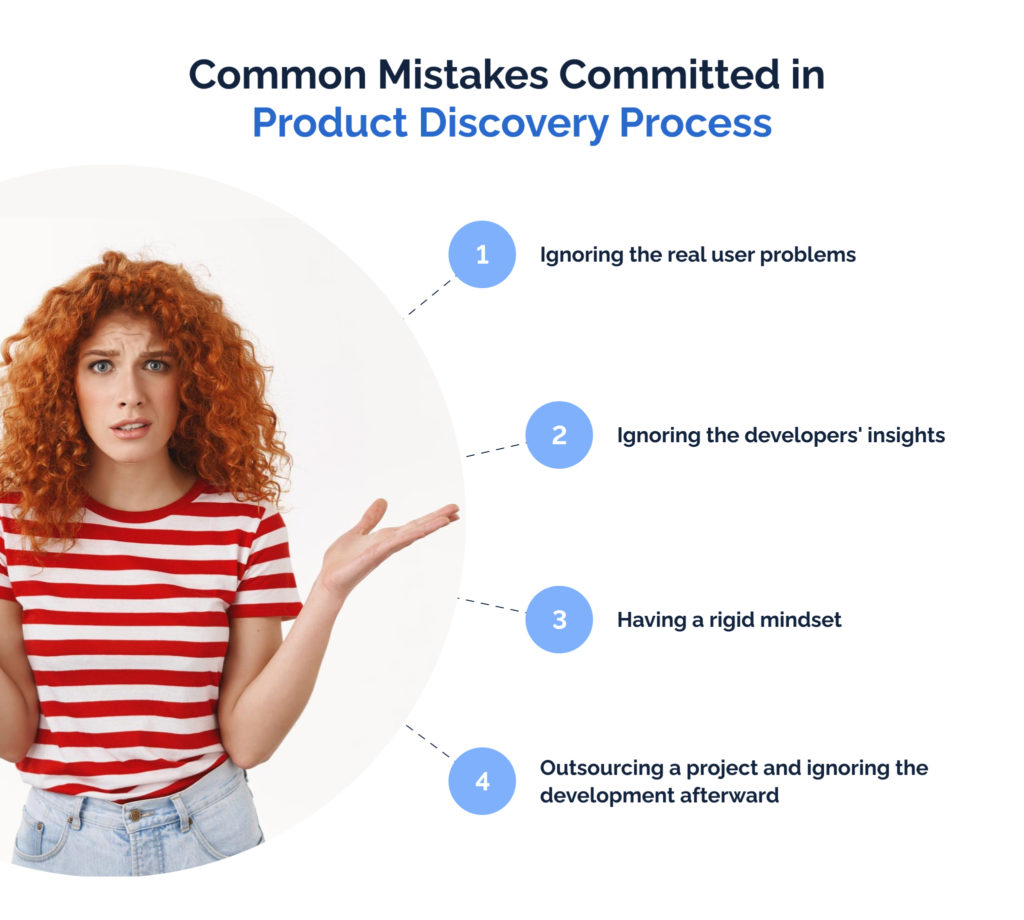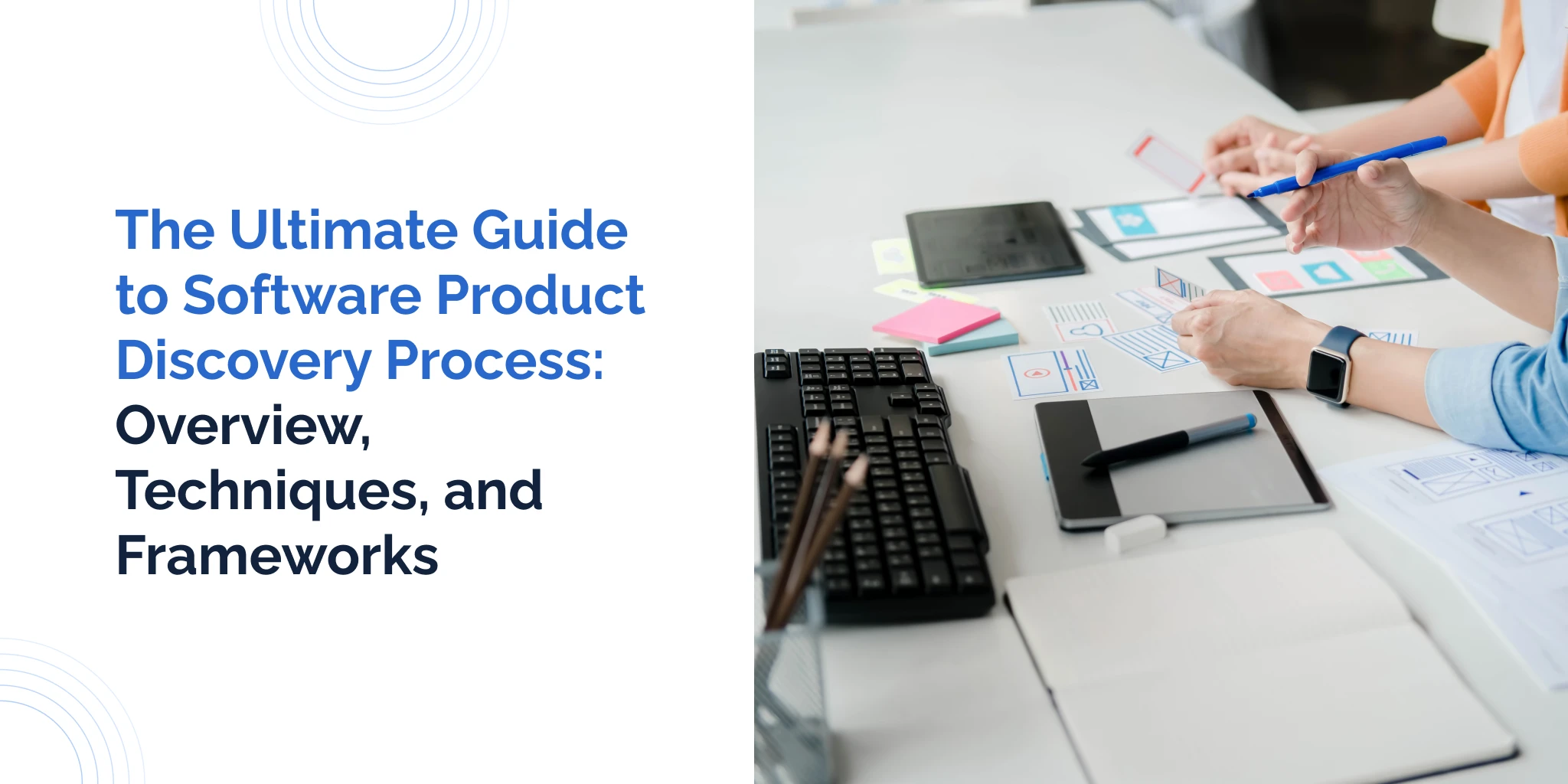Proper product discovery is a pathway to project success. Learn how to perform it in this article!
The key goal of any business is to innovate. This aspect is especially important for the IT sector because it’s at the forefront of research. In this regard, multiple businesses failed or are on the verge of failing despite tremendous strength in the past. Youtube is losing the market to Tiktok, for example. Even the seemingly all-mighty Google is now in a bad shape: it fell behind in artificial intelligence, with its Bard platform being inferior to ChatGPT used by Microsoft. Upcoming years may easily see the end of Google’s domination even though the company has tremendous influence today. In this light, the software product discovery phase is essential for all businesses. This article reviews the process that can help your company innovate and survive in the market. We’ll define the concept and describe the necessary techniques and frameworks.
What is Product Discovery?
Product discovery is about identifying and validating a product idea or a concept. It involves research and analysis to determine if a potential project solves a customer problem, meets market demand, and aligns with the business goals and objectives. For instance, your team may develop an idea for a fitness app capable of tracking weight changes based on food intake and activities. The idea may seem useful because, let’s say, the developers are interested in sports, but the team members can still be unsure about the potential due to market saturation. Via the product discovery process, your team can study the fitness app market and understand if the potential product targets the customers’ real problems.
When and why do we need product discovery?
As you can understand from the aforementioned definition, product discovery is about realizing if a certain product idea is viable. This factor defines the main reason to use product discovery: it can help teams make a decision about developing a particular piece of software. Our fitness app example above may seem good on paper, but there’s a catch: multiple apps already perform the same service. In our opinion, we need product discovery at all times and in all projects. As Ryan Holiday, a self-improvement author and a marketing specialist notes, ego is always the enemy. Without product discovery, one may begin developing software without a clear future in the market due to some team members’ individual wishes and ambitions. Even in seemingly obvious cases, performing product discovery is crucial: what seems obvious often isn’t self-evident.
What team structure do you need for product discovery?
Product discovery typically involves a cross-functional team of designers, developers, marketers, and other stakeholders who work together to understand user needs, define product requirements, and explore potential solutions. As you may see, one of the key features, in this case, is the multifaceted nature of a team. If you entrust the product discovery process only to one group (for example, the developers or marketing specialists), missing some vital objections or additions to the plan is easy. Marketing specialists may have a great app in mind, but its development can be too expensive once the software developers offer their input.
Product discovery questions
How to do product discovery? Here are some product discovery questions that can be used during the process:
- What problem does this product solve?
- Who are the target users of this product?
- What are the needs and pain points of our target users?
- What existing solutions are available in the market?
- What are our product’s unique features or benefits compared to existing solutions?
- How will our product generate value for our target users and our business?
- What are the technical requirements and constraints for building this product?
- What is the expected timeline and budget for developing and launching this product?
- How will we measure the success of this product?
- What are the potential risks and challenges associated with developing and launching this product?
The outcome of the product discovery process
The main outcome of the product discovery process includes a set of validated requirements capable of helping with developing the product further. Product discovery techniques assist with the creation of clear guidelines for a particular software. Another typical outcome is the roadmap of the features one should add. In short, the idea, in this case, is to offer a full-scale description of the relevant app or site.
The Goal of Product Discovery
The ultimate goal of product discovery is to create a valuable, usable, and feasible product. Product discovery is about removing ideas that don’t work and upgrading the frameworks that show promise. By conducting thorough research and analysis during the product discovery phase, a team can increase the chances of developing a successful piece of software that meets customers’ needs and achieves the business goals.
The Importance of Discovery

Product discovery techniques are important for several major reasons. Firstly, product discovery is crucial for aligning certain products with the needs of potential clients. This approach helps with achieving high popularity. Secondly, product discovery is essential for reducing risks. Many ideas seem good on paper. In reality, most startups and projects from large companies are bound to fail. When you have a clear process in mind, it’s easier to avoid mistakes that can be fatal to a project.
Discovery Phase 1: Initiation
The first step to consider in product discovery is initiation. During it, you acknowledge the need to analyze a particular idea because it can benefit clients and the development company. The key goal during this stage is to create a strong team capable of enabling the product discovery framework. What should you do during this stage? Start with a series of ‘kick-off’ meetings: communicate with the stakeholders from different departments and unite them into one strong team. One must organize a group capable of offering diverse and valuable perspectives on product development. The key mistake here is focusing on individuals who belong to one department.
Discovery Phase 2: Research and Analysis
Once you feature a well-established team, it’s time to start a full-scale analysis of the aspects that have to do with the product idea. You can always address our team if you struggle with this component. One of the key elements requiring analysis is the market itself. It’s crucial to understand who your competitors are and what they offer and realize how to work with the potential target audience. The awareness of competitor strengths highlights your potential weaknesses. In turn, their knowledge of weaknesses may become your main strength. As for the target audience, the knowledge helps with advertisement and feature delivery. Now, let’s review those aspects in depth:
Competitor Analysis
Competitor analysis involves the review of all the key competitive features that the potential opponents have. It’s among the most important steps in the discovery process What should you do here? We recommend analyzing the following features:
1) Number of visitors on the competitors’ URLs;
2) Age distribution of the visitors and users;
3) Experience of the company in the market;
4) Key features that the relevant company offers;
5) Strengths, weaknesses, threats, and opportunities based on the existing actions regarding the market.
To analyze the key features and to perform the SWOT review, one should primarily scrutinize the competitor’s product and use it in real-life situations. Many companies provide trial versions: use them to form some first impressions. Analyze the visual design, the interactions, and the functions and add them to the strength/weaknesses matrix. This approach will help you understand where the market gaps are and what’s necessary to close the problems of your project.
Another high-quality practice our company uses is the 5 Whys technique, or the so-called root cause analysis. The idea, in this case, is to understand how the competitors think. What is the idea behind root cause analysis? You ask five or, sometimes, more/fewer questions to understand the main reasons a particular product is popular. Let’s try out an example of this technique with an imagined fitness software helping people track their calories:
- Problem: FitTrackerSoftware has a strong market lead.
- Why 1? Why does it have a strong market lead? Because it has a user-friendly app.
- Why 2? Why is the app user-friendly? Because it offers automatic calorie analysis.
- Why 3? Why does automatic calorie analysis matter? Because it saves time and is simple.
- Why 4? Why do users value simplicity? Because the process of losing weight is hard.
- Why 5? Why is the process of losing weight hard? Because it requires discipline.
- Root cause of popularity: clients use the app to boost their discipline.
- Potential competitive solution: add features that automate activities necessary for a high level of discipline.
- Observations: the presented case shows how vital the root cause analysis is. Initially, one may expect that certain features carry the app. In reality, user psychology is behind it. It’s not the features that matter in this case but the ability to satisfy the customers’ needs. Root cause analysis is notable for often showing that the expected reasons for dominance differ from the real ones.
Target Audience Analysis
After you understand the competitor’s products, it’s time to transition toward another vital market aspect. In this regard, what matters is the potential target audience. You should answer the following questions: who are your final users? Why will they use the product? In what conditions will they use the product? In this case, the key action is interviewing different individuals who can be your potential customers. Its result is the so-called user persona.
What is the user persona? A user persona is a fictional character representing a typical product or service user. It’s created based on research and data about the target audience and their needs, goals, behaviors, motivations, and pain points. User personas help teams empathize with their users and design solutions that meet their needs and expectations. They can also guide decision-making, prioritize features, and communicate user insights across organizations. A user persona typically includes demographic information, such as age, gender, education, and job title, as well as psychographic information, such as personality traits, interests, and values. It may also include a backstory, goals, tasks, and challenges related to the designed product or service. In the product discovery process, user persona helps you understand what features to prioritize based on the potential users.
Discovery Phase 3: Ideation
In most cases, software companies perform the presented actions for a particular stakeholder (for example, some clients). This means the best idea is to discuss the product discovery process with them. Our company uses a workshop format to deliver information about particular wares to the customers. We develop a Customer Journey Map together with the clients. It helps visualize the process through which a customer goes to achieve the key goals of the product. Such a framework allows the client to have a maximal influence on the development practices. The main aim of ideation is to interconnect the clients’ motivations with the users’ needs and pain points.
Upon explaining the users’ requirements, one should also present an outline of the features making the process usable and useful. In this regard, both the clients and the developers input their ideas and decide on the features one needs to include in the project. You fully define the vision, key objectives, and the success criteria of the relevant product here. This information should be sufficient to start developing a prototype.
Discovery Phase 4: Solution Framing
This step of the product discovery process is about testing the solutions you’ve developed. Based on previous research, one should offer a visual representation of your software and a full-scale prototype. Let’s look at the key steps to consider in this regard:
Wireframing
Wireframing is about creating an approximate visual representation of your UI (user interface). It can be a sketch made by your designers on paper or in software such as Figma. The idea is to see how the overall visuals of your product would function without exerting major effort. Wireframes are an important part of the design process because they help designers to validate their assumptions and identify potential issues before investing time and resources into high-fidelity designs. They also provide a clear framework for developers to follow when building the final product. Another vital benefit is the reduced need for rework and revisions.
Related Services
UI/UX DESIGN
Prototyping
Wireframing will eventually lead you to a version of the user interface that satisfies everyone. At this point of the product discovery process, the best idea is to transition toward the prototyping phase. During it, you create a minimum viable product version that one can test. A prototype has benefits similar to wireframing: it lets one see if your idea works.
Related Services
MINIMUM VIABLE PRODUCT
User Testing
Prototypes are necessary for one of the most crucial steps in the entire development process, user testing. You should ask real users to see if your product functions well. User testing is crucial to the design process because it provides valuable insights into how users interact with a product. It helps identify usability issues, pain points, and opportunities for improvement. User testing also validates design decisions, ensures the product meets the user’s needs and expectations, and reduces the risk of costly redesigns and rework. By involving users in the design process, designers create more intuitive, engaging, and friendly products, leading to increased satisfaction and loyalty. Ultimately, user testing ends in a better product that meets the client’s needs and achieves business goals.
Related Services
DEVELOPMENT AND TESTING
Product Discovery Frameworks

Multiple product discovery frameworks exist. Let’s review some of them:
Design thinking: Product-centric analysis
Design thinking is a problem-solving approach focusing on understanding users’ needs and creating innovative solutions to meet those needs. It involves empathy, ideation, prototyping, and testing to create user-centered solutions that are practical, feasible, and desirable. The process described above is, more or less, a representation of this framework.
Jobs-to-be-done (JTBD): Customer-centric analysis
The Jobs-to-be-Done (JTBD) framework is a product discovery process that shifts the focus from user personas and demographics to the underlying motivation behind why users hire a product to accomplish a specific job. Rather than asking users what they want, JTBD aims to identify the “job” users are trying to get done and the progress they’re trying to make in their lives. This approach allows designers and product managers to understand the context and desired outcome of a user’s decision to use a product and the alternatives and trade-offs they consider.
Riskiest assumption test: Assumption-centric analysis
The Riskiest Assumption Test (RAT) is a framework for validating assumptions and reducing risk in the early stages of a startup or product development. It involves identifying the key assumptions underlying a business idea or product and testing the riskiest assumptions to validate or invalidate them. By focusing on the riskiest assumptions, RAT helps entrepreneurs and product teams quickly and cheaply learn what works and what doesn’t and to iterate and pivot based on user feedback and market insights. RAT is often used with lean startup methodologies, such as the Lean Canvas and MVP (Minimum Viable Product) testing.
Here’s a simple example of RAT:
- Assumption: People will pay for an online meal delivery service that offers healthy and convenient meals.
- Riskiest Assumption: People are willing to pay for a meal delivery service.
- Test: Conduct a survey or interview potential customers to see if they would be willing to pay for a meal delivery service. Provide different pricing options and meal plans to gauge their willingness to pay.
- Based on the results, you can validate or invalidate the riskiest assumption. If customers are willing to pay, you may move on to testing other assumptions, such as the types of meals they prefer or the most effective marketing channels. If customers aren’t willing to pay, you can either pivot your business model or abandon the idea altogether, saving time and resources.
Product Discovery Techniques and Tools
Let’s look at other ways to enhance the product discovery process. These approaches are simpler and involve some additional knowledge capable of helping your company:
Lean Canvas: A 1-page project planning framework
The Lean Canvas is a one-page business plan template that helps entrepreneurs and product teams to visualize and validate their business idea. It includes nine key elements, such as customer segments, value proposition, revenue streams, and cost structure, which can be used to identify and prioritize the most important aspects of a startup or product.
Value Proposition Canvas
The Value Proposition Canvas is a tool helping businesses understand their customers’ needs and design products or services that meet those needs better than competitors. It includes two main components: the Customer Profile, which identifies customers’ jobs, pains, and gains, and the Value Map, which outlines how the product or service alleviates those pains and creates gains. This is a perfect addition to the Design Thinking framework and its software product discovery process.
Common Mistakes Committed in Product Discovery Process

1. Ignoring the real user problems
The first issue of many designers is that they imagine user problems instead of asking them about their pains. A good example of this issue is Google+. Google’s managers thought that Facebook failed to provide enough comfort to the users and tried to make an alternative. The reality proved daunting: many real users (rather than the imagined ones) loved and continue to love Facebook, refusing to transition towards the new and relatively unknown network. Having users’ personas and ‘jobs’ as product discovery tools is a great idea. Imagining what people belonging to that group do without asking them is illogical.
2. Ignoring the developers’ insights
Some teams think that developers can do anything. They perform the product discovery techniques without them and, ultimately, doom the products. Why? Firstly, developers are the go-to people when you want to learn if the project is feasible. When you fail to involve them, creating an overloaded or overly expensive project idea is easy. Secondly, these people are at the forefront of the tech development world. They know about the key trends and can offer high-quality advice on the main features. Ignoring their input is often dangerous for a project.
3. Having a rigid mindset
Sometimes, people fall in love with certain ideas too much. This leads to situations when they refuse to abandon some ideas because they seem strong despite the evidence. What is a product discovery process? It’s a process of perpetual change. Your initial idea of a project may turn into something entirely different with time. One must be ready to abandon their vision and transition into something novel.
4. Outsourcing a project and ignoring the development afterward
Software product discovery process requires constant input from all stakeholders. If you outsource the product and ignore its development, don’t be surprised that it doesn’t meet your expectations. The developers have visions and life experiences that lead them toward personalized solutions. When a client wants a product fitting their needs, it’s vital to be as involved in the development process as possible. Visit every product discussion meeting and offer your input. Your vision can prevail only if you talk about it.
Conclusion
To summarize, the product discovery process has clear steps. All you have to do is follow them carefully, and you’ll achieve success. Our company strictly maintains many outlined practices, so you can rely on us for product discovery. Don’t hesitate to use the advice from this article: proper product discovery is central to the success of many companies.
Frequently asked questions about the product discovery process.
What does product discovery stand for?
Product discovery involves researching and testing ideas to identify customer needs and create successful products.
What are the key elements of product discovery?
Key elements of product discovery include identifying customer needs, analyzing the competitors, defining the user pain, testing assumptions through user interviews and client feedback, and validating solutions through experimentation.
What are the models of product discovery?
They involve design thinking, jobs to be done, and the riskiest assumption test.
Why is product discovery important?
Product discovery is important because it helps create successful products that meet customer needs, reduce waste/revisions, and increase business value.
Hire professionals to help you with this process. Our company is here to assist you!












